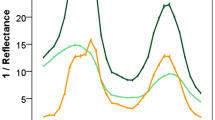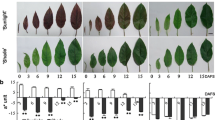Abstract
The acclimation mechanisms of two berry color variant grapevine leaves, Furmint White (FW) and Furmint Red (FR), to natural sunlight conditions were investigated comparing leaves from two distinct locations: at canopy surface (sun-exposed leaves) and in the inner layers (shaded leaves). We found that in contrast to FR leaves, sun-exposed FW leaves were thicker than shaded leaves due to thicker palisade tissues. Confocal laser scanning microscopy of Naturstoff-treated leaf segments revealed that flavonoids were accumulated in nuclei, cell walls, cytoplasm, and chloroplasts of the adaxial epidermal and palisade layers of sun-exposed leaves in both cultivars. High-performance liquid chromatography analysis showed that the main phenolic components in both cultivars were caftaric acid and various glycosylated flavonols. Among the latter, the dominant component was quercetin glucuronide in both cultivars, unaffected by light conditions. However, caftaric acid and quercetin glucoside were present in significantly higher amounts in sun-exposed than in shaded leaves of both cultivars, but the effect of light conditions on caftaric acid contents was more pronounced in FR than in FW. Accordingly, the total polyphenol content of leaf extracts characterized by Folin-reagent reactivity was more enhanced in sun-exposed leaves of FR, than in FW. Our data suggest two different sunlight acclimation strategies to protect photosynthetic mesophyll tissues from potential photo-oxidative damage. One is realized in FW leaves as stronger shading by thicker palisade layer accompanied by enhanced chemical defense. The other is achieved in FR leaves via a more pronounced increase in caftaric acid and total polyphenol content but without morphological adjustments.




Similar content being viewed by others
References
Agati G, Galardi C, Gravano E, Romani A, Tattini M (2007) Flavonoid distribution in tissues of Phillyrea latifolia L. leaves as estimated by microspectrofluorometry and multispectral fluorescence microimaging. Photochem Photobiol 76:350–360
Agati G, Stefano G, Biricolti S, Tattini M (2009) Mesophyll distribution of ‘antioxidant’ flavonoid glycosides in Ligustrum vulgare leaves under contrasting sunlight irradiance. Ann Bot Lond 104:853–861
Agati G, Azzarello E, Pollastri S, Tattini M (2012) Flavonoids as antioxidants in plants: location and functional significance. Plant Sci 196:67–76
Andelković M, Radovanović B, Andelković AM, Radovanović V (2015) Phenolic compounds and bioactivity of healthy and infected grapevine leaf extracts from red varieties Merlot and Vranac (Vitis vinifera L.). Plant Foods Hum Nutr 70:317–323
Berli F, D’Angelo J, Cavagnaro B, Bottini R, Wuilloud R, Silva MF (2008) Phenolic composition in grape (Vitis vinifera L. cv. Malbec) ripened with different solar UV-B radiation levels by capillary zone electrophoresis. J Agric Food Chem 56(9):2892–2898
Brunetti C, Di Ferdinando M, Fini A, Pollastri S, Tattini M (2013) Flavonoids as antioxidants and developmental regulators: relative significance in plants and humans. Int J Mol Sci 14:3540–3555
Buckley TN, Sack L, Golert ME (2011) The role of bundle sheath extensions and life form in stomatal response to leaf water status. Plant Physiol 156:962–973
Buer CS, Imin N, Djordjevic MA (2010) Flavonoids: new roles for old molecules. J Integr Plant Biol 52:98–111
Chacón JL, García E, Martínez J, Romero R, Gómez S (2009) Impact of the vine water status ont he berry and seed phenolic composition of’Merlot’ (Vitis vinifera L.) cultivated in a warm climate: consequence for the style of wine. Vitis 48:7–9
Chavarria G, Santos PH, Castro LAS, Marodin GAB, Bergamaschi H (2012) Anatomy, chlorophyll content and photosynthetic potential in grapevine leaves under plastic cover. Revista Brasileira de Fruticultura 34:661–668
Csepregi K, Kocsis M, Hideg É (2013) On the spectrophotometric determination of total phenolic and flavonoid contents. Acta Biol Hung 64:500–509
Csepregi K, Neugart S, Schreiner M, Hideg É (2016) Comparative evaluation of total antioxidant capacity of plant polyphenols. Molecules 21:1–17. doi:10.3390/molecules21020208
Dani C, Oliboni LS, Agostini F, Funchal C, Serafini L, Henriques JA, Salvador M (2010) Phenolic content of grapevine leaves (Vitis labrusca var. Bordo) and its neuroprotective effect against peroxide damage. Toxicol In Vitro 24:148–153
Di Ferdinando M, Brunetti C, Agati G, Tattini M (2014) Multiple functions of polyphenols in plants inhabiting unfavorable Mediterranean areas. Environ Exp Bot 103:107–116
Downey MO, Dokoozlian NK, Krstic MP (2006) Cultural practice and environmental impacts on the flavonoid composition of grapes and wine: a review of recent research. Am J Enol Vitic 57:257–268
Erlejman AG, Verstraiten SV, Graga CG, Oteiza PI (2004) The interaction of flavonoids with membranes: potential determinants of flavonoid antioxidant effects. Free Radic Res 38:1311–1320
Farhadi K, Esmaeilzadeh F, Hatami M, Forough M, Molaie R (2016) Determination of phenolic compounds content and antioxidant activity in skin, pulp, seed, cane and leaf of five native grape cultivars in West Azerbaijan province. Iran. Food Chem 199:847–855
Feder N, O’Brien TP (1968) Plant microtechnique: some principles and new methods. Am J Bot 55:123–142
Fernandes F, Ramalhosa E, Pires E, Verdial J, Valentao P, Andrade P, Bento A, Pereira JA (2013) Vitis vinifera leaves towards bioactivity. Ind Crop Prod 43:434–440
Flamini R, Traldi P (2010) Grape and Wine Polyphenols. In: Desiderio DM, Nibbering NMM (eds) Mass spectrometry in grape and wine chemistry. Wiley, New Jersey, pp 163–214
Götz M, Albert A, Stitch S, Heller W, Scherb H, Krins A, Langebartels C, Seidlitz HK, Ernst D (2010) PAR modulation of the UV-dependent levels of flavonoid metabolites in Arabidopsis thaliana (L.) Heynh. leaf rosettes: cumulative effects after a whole vegetative growth period. Protoplasma 243:95–103
Grünz G, Daniel H, Spanier B (2010) In vitro visualization of flavonoids in C. elegans using 2-aminoethyl diphenyl borate. The Worm Breeder’s. Gazette 2:13
Hatier JHB, Gould KS (2008) Foliar anthocyanins as modulators of stress signals. J Theor Biol 253:625–627
Hernández I, Alegre L, Van Breusegem F, Munné-Bosch S (2009) How relevant are flavonoids as antioxidants in plants? Trends Plant Sci 14:125–132
Hutzler P, Fischbach R, Heller W, Jungblut TP, Reuber S, Schmitz R, Veit M, Weissenbeck G, Schnitzler JP (1998) Tissue localization of phenolic compounds in plants by confocal laser scanning microscopy. J Exp Bot 49:953–965
Igersheim A, Cichocki O (1996) A simple method for microtome sectioning of prehistoric charcoal specimens, embedded in 2-hydroxethyl methacrylate (HEMA). Rev Palaeobot Palyno 92:389–393
Inoue K (2011) Emerging roles of the chloroplast outer envelope membrane. Trends Plant Sci 16:550–557
Kakani VG, Reddy KR, Zhao D, Sailaja K (2003) Field crop responses to ultraviolet-B radiation: a review. Agric Forest Meteorol 120:191–218
Kocsis M, Abrankó L, Ayaydin F, Csepregi K, Papp N, Teszlák P, Jakab G (2015) Main leaf polyphenolic components of berry color variant grapevines and their acclimative responses to sunlight exposure. Appl Sci 5:1955–1969
Kolb CA, Kaser MA, Kopecky J, Zotz G, Riederer M, Pfündel EE (2001) Effects of natural intensities of visible and ultraviolet radiation on epidermal ultraviolet screening and photosynthesis in grape leaves. Plant Physiol 127:863–875
Kosar M, Küpeli E, Malyer H, Uylaser V, Türkben C, Baser KH (2007) Effect of brining on biological activity of leaves of Vitis vinifera L. (cv. Sultani Cekirdeksiz) from Turkey. J Agric Food Chem 55:4596–4603
Lima A, Bento A, Baraldi I, Malheiro R (2016) Selection of grapevine leaf varieties for culinary process based on phytochemical composition and antioxidant properties. Food Chem 212:291–295
Mané C, Souquet JM, Ollé D, Verriés C, Véran F, Mazerolles G, Cheynier V, Fulcrand H (2007) Optimization of simultaneous flavanol, phenolic acid, and anthocyanin extraction from grapes using an experimental design: application to the characterization of champagne grape varieties. J Agric Food Chem 55:7224–7233
Markstädter C, Queck I, Baumeister J, Riederer M, Schreiber U, Bilger W (2001) Epidermal transmittance of leaves of Vicia faba for UV radiation as determined by two different methods. Photosynth Res 67:17–25
Martin G, Josserand SA, Bornman JF, Vogelman TC (1989) Epidermal focussing and the light microenvironment within leaves of Medicago sativa. Physiol Plant 76:485–492
Monagas M, Hernández-Ledesma B, Gómez-Cordovés C, Bartolomé B (2006) Commercial dietary ingredients from Vitis vinifera L. leaves and grape skins: antioxidant and chemical characterization. J Agric Food Chem 54:319–327
Mullineaux P, Karpinski S (2002) Signal transduction in response to excess light: getting out of the chloroplast. Curr Opin Plant Biol 5:43–48
Nagel LM, Bassmann JH, Edwards GE, Robberecht R, Franceshi VR (1998) Leaf anatomical changes in Populus trichocarpa, Quercus rubra, Pseudotsuga menziesii, and Pinus ponderosa exposed to enhanced ultraviolet-B radiation. Physiol Plant 104:385–396
Németh M (1967) Ampelographic album: cultivated grapevine cultivars. I, 1st edn. Agricultural Press, Budapest, pp 140–150
Pérez-Gregorio MR, Regueiro J, González-Barreiro C, Rial-Otero R, Simal-Gándara J (2011) Changes in antioxidant flavonoids during freeze-drying of red onions and subsequent storage. Food Control 22:1108–1113
Polster J, Dithmar H, Burgemeister R, Friedemann G, Feucht W (2006) Flavonoids in plant nuclei: detection by laser microdissection and pressure catapulting (LMPC), in vivo staining, and UV-visible spectroscopic titration. Physiol Plant 126:163–174
Ramakrishna A, Ravishankar GA (2011) Influence of abiotic stress signals on secondary metabolites in plants. Plant Signal Behav 6:1720–1731
Reinert F, Leal-Costa MV, Junqueira NE, Tavares ES (2013) Are sun- and shade-type anatomy required for the acclimation of Neoregelia cruente? An Acad Bras Cienc 85:561–573
Rice-Evans CA, Miller NJ, Paganga J (1997) Antioxidant properties of phenolic compounds. Trends Plant Sci 2:152–159
Saslowsky DE, Warek U, Winkel BSJ (2005) Nuclear localization of flavonoid enzymes in Arabidopsis. J Biol Chem 25:23735–23740
Schoedl K, Schuhmacher R, Forneck A (2012) Studying the polyphenols of grapevine leaves according to age and insertion level under controlled conditions. Sci Hortic 141:37–41
Sheahan JJ, Cheong H, Rechnitz GA (1998) The colorless flavonoids of Arabidopsis thaliana (Brassicaceae). I. A model system to study the orthodihydroxy structure. Am J Bot 85:467–475
Silva AS, Oliveira JG, Da Cunha M, Vitória AP (2010) Photosynthetic performance and anatomical adaptations in Byrsonima sericea DC. under contrasting light conditions in a remnant of the Atlantic forest. Braz J Plant Physiol 22:245–254
Tattini M, Gravano E, Pinelli P, Mulinacci N, Romani A (2000) Flavonoids accumulate in leaves and glandular trichomes of Phillyrea latifolia exposed to excess solar radiation. New Phytol 148:69–77
Tattini M, Galardi C, Pinelli P, Massai R, Remorini D, Agati G (2004) Differential accumulation of flavonoids and hydroxycinnamates in leaves of Ligustrum vulgare under excess light and drought stress. New Phytol 163:547–561
Tattini M, Guidi L, Morassi-Bonzi L, Pinelli P, Remorini D, DeglInnocenti E, Giordano C, Massai R, Agati G (2005) On the role of flavonoids in the integrated mechanisms of response of Ligustrum vulgare and Phillyrea latifolia to high solar radiation. New Phytol 167:457–470
Tattini M, Remorini D, Pinelli P, Agati G, Saracini E, Traversi ML, Massai R (2006) Morpho-anatomical, physiological and biochemical adjustments in response to root zone salinity stress and high solar radiation in two Mediterranean evergreen shrubs, Myrtus communis and Pistacia lentiscus. New Phytol 170:779–794
Tholen D, Boom C, Zhu XG (2012) Opinion: prospects for improving photosynthesis by altering leaf anatomy. Plant Sci 197:92–101
Weber B (1992) Phenolische Komponenten des Weinrebenblattes: Identität und phytoathologische Bedeutung. Dissertation. University of Zürich, Germany
Zaprometov MN, Nikolaeva TN (2003) Chloroplasts isolated from kidney bean leaves are capable of phenolic compound biosynthesis. Russ J Plant Physiol 50:623–626
Acknowledgements
The research was supported by the Hungarian Scientific Grant Agency (OTKA K101430). The present scientific contribution is dedicated to the 650th anniversary of the foundation of the University of Pécs, Hungary.
Author information
Authors and Affiliations
Corresponding author
Ethics declarations
Conflict of interest
The authors declare no conflict of interest.
Additional information
Communicated by L. Bavaresco.
Rights and permissions
About this article
Cite this article
Kocsis, M., Ayaydin, F., Kőrösi, L. et al. Contrasting acclimation mechanisms of berry color variant grapevine cultivars (Vitis vinifera L. cv. Furmint) to natural sunlight conditions. Acta Physiol Plant 39, 178 (2017). https://doi.org/10.1007/s11738-017-2481-y
Received:
Revised:
Accepted:
Published:
DOI: https://doi.org/10.1007/s11738-017-2481-y




